Jacob poetically deplored all the bad news in a comment to the last post.
So here's something entirely different.
I'm reading a book for my book club called Fuzz by Mary Roach. She shadows people who are dealing with animal/human conflicts around the world. It started with bears, then to elephants, and now I'm in a chapter on leopards.
The forestry official working with villagers in northern India has set up solar powered lights that intermittently go on and off during the night, which, they surmise, mimics people with flashlights, which keeps the leopards at bay. But the villagers wanted to leave the lights on all night, which, they say, is less effective. At that point, Roach tells us rangers had similar problems in Colorado trying to convince ranchers to use fladry.
So here's something very different - an explanation of how to use fladry.
Where did this word come from? Here's part of a discussion on the etymology of the word from German Language/Deutsche Sprache::
"Fladry' is a comparatively recent adoption in English from Polish, with a putative origin in German. The Double-Tongued Dictionary gives this definition and partial etymology:
fladry n.pl. a string of flags used to contain or exclude wild animals. ... Etymological Note: According to Polish Scientific Publishers (Wydawnictwo Naukowe PWN, SA), fladry is the plural of flader, which comes from German. It is not specified which German word, but it’s probably related to flattern ‘to flutter.’ It is probably not related to the Polish flÄ…dry, the plural of flÄ…dra, which according to the Oxford PWN Polish English Dictionary (2002, Oxford University Press) means “1. flounder, flatfish; 2. slattern, slut.”
I have found 'fladry' in English in the sense of "a string of flags etc." as early as 1993, in a technical paper titled "Status and Management of the Wolf in Poland" (Biological Conservation; see, for example, the abstract)."






















































